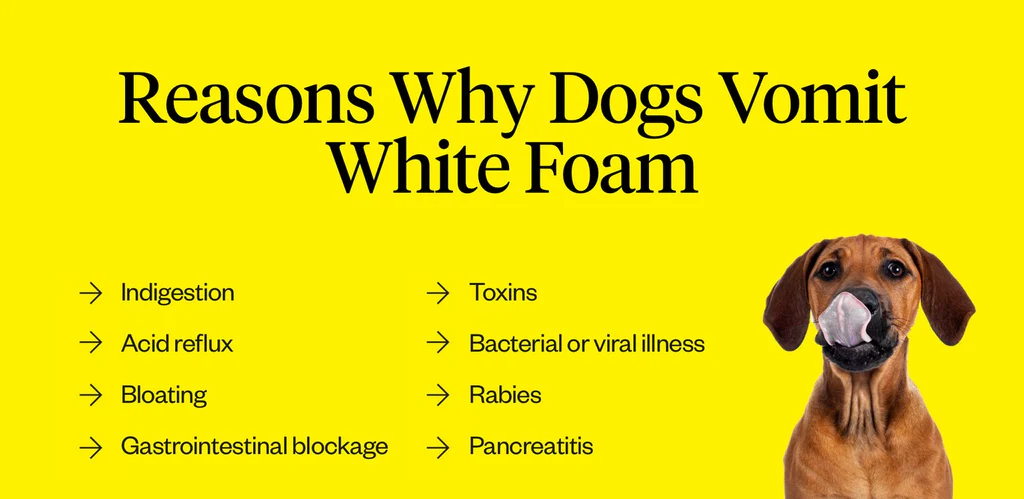Seeing your Dog Throwing Up White Foam can be distressing. While occasional vomiting might not be cause for alarm, persistent or severe symptoms warrant closer attention. Understanding the potential causes and knowing when to seek veterinary care can help ensure your furry friend stays healthy. In this article, we’ll explore why dogs vomit white foam, what it might mean, and the steps you can take to help them.
What Does White Foam Vomit Indicate?
White foam in a dog’s vomit usually indicates that the stomach is empty, and the dog is expelling bile or mucus. This can happen for various reasons, ranging from minor issues to more serious health concerns. Here’s a closer look at some common causes:
1. Empty Stomach or Hunger Pangs
One of the most common reasons for white foam vomiting is an empty stomach. If a dog goes too long without eating, bile, which is a digestive fluid, can build up and irritate the stomach lining. This irritation can lead to vomiting white foam. This is often referred to as bilious vomiting syndrome.
2. Gastritis
Gastritis, or inflammation of the stomach lining, can also cause vomiting of white foam. This condition might be triggered by eating something that doesn’t agree with the dog’s stomach, such as spoiled food or foreign objects. Gastritis can lead to nausea and vomiting, often accompanied by discomfort or pain.
3. Indigestion or Gastroenteritis
Indigestion or gastroenteritis, which is inflammation of the stomach and intestines, can cause a dog to vomit white foam. This may be due to dietary indiscretion, such as consuming something inappropriate or toxic. Gastroenteritis is often accompanied by other symptoms like diarrhea, lethargy, and loss of appetite.
4. Pancreatitis
Pancreatitis, an inflammation of the pancreas, can result in white foam vomiting. This condition is usually caused by a high-fat diet or eating rich foods. Pancreatitis can cause severe abdominal pain, vomiting, and loss of appetite. It’s a serious condition that requires prompt veterinary attention.
5. Infections or Parasites
Certain infections or parasites can cause gastrointestinal upset, leading to vomiting white foam. These may include viral infections, bacterial infections, or parasitic infestations. Symptoms might also include diarrhea, weight loss, and lethargy.
6. Toxic Ingestion
If a dog ingests something toxic, such as certain plants, chemicals, or human medications, it may vomit white foam as a reaction. Toxic ingestion often leads to other symptoms, such as drooling, lethargy, or unusual behavior, and requires immediate veterinary attention.
When to Worry: Signs That Require Veterinary Attention
While occasional white foam vomiting may not be a cause for concern, there are specific signs that indicate a more serious problem. Seek veterinary care if your dog exhibits any of the following:
1. Persistent Vomiting
If your dog continues to vomit white foam or vomits frequently over a period of time, it’s important to consult your vet. Persistent vomiting can lead to dehydration and may indicate a more severe underlying issue.
2. Additional Symptoms
Other symptoms accompanying white foam vomiting, such as diarrhea, lethargy, abdominal pain, or blood in the vomit, should be taken seriously. These signs could point to a more severe condition that needs medical intervention.
3. Changes in Behavior
If your dog’s behavior changes significantly, such as becoming unusually lethargic or irritable, it could be a sign of illness. Significant changes in behavior combined with vomiting warrant a veterinary evaluation.
4. Exposure to Toxins
If you suspect your dog may have ingested something toxic, seek veterinary care immediately. Time is crucial in cases of poisoning, and prompt treatment can be life-saving.
Steps to Take When Your Dog Vomits White Foam
Here’s what you can do if your dog vomits white foam:
1. Monitor Your Dog
Observe your dog closely for any additional symptoms or changes in behavior. Keep track of how often your dog vomits and note any other signs, such as diarrhea or changes in appetite.
2. Withhold Food Temporarily
If your dog vomits, it’s often helpful to withhold food for 12-24 hours to give the stomach a chance to settle. Ensure your dog has access to fresh water to stay hydrated. Avoid giving treats or table scraps during this period.
3. Reintroduce Food Gradually
Once the vomiting has stopped and your dog appears to be feeling better, reintroduce food gradually. Start with a bland diet, such as boiled chicken and rice, and observe how your dog responds. Gradually return to their regular diet if there are no signs of further issues.
4. Consult Your Veterinarian
If the vomiting persists or if you notice concerning symptoms, contact your veterinarian. They can perform a thorough examination, conduct diagnostic tests if needed, and provide appropriate treatment based on the underlying cause.
Preventing Future Incidents
To minimize the risk of future vomiting episodes, consider these preventive measures:
1. Maintain a Regular Feeding Schedule
Feed your dog at regular intervals and avoid skipping meals. Keeping your dog’s stomach regularly full can help prevent the build-up of bile and reduce the risk of vomiting.
2. Avoid Feeding Harmful Foods
Ensure that your dog does not have access to harmful foods, such as rich or fatty treats, table scraps, or toxic plants. Stick to high-quality dog food and avoid giving human foods that can upset their digestive system.
3. Regular Vet Check-ups
Routine veterinary check-ups can help catch any underlying health issues before they become serious problems. Regular exams ensure that your dog remains in good health and receives appropriate vaccinations and preventive care.
4. Monitor Your Dog’s Environment
Be mindful of potential hazards in your dog’s environment, such as chemicals or small objects they could ingest. Keeping your home safe and dog-proofed can help prevent accidental ingestion of harmful substances.
Conclusion
White foam vomiting in dogs can be caused by a variety of issues, from minor digestive disturbances to more serious health concerns. While occasional vomiting might not be alarming, persistent or severe symptoms should be addressed by a veterinarian. By understanding the potential causes and knowing when to seek help, you can ensure that your dog remains healthy and comfortable.
If you’re ever in doubt about your dog’s health, don’t hesitate to consult with your veterinarian for guidance and peace of mind.







